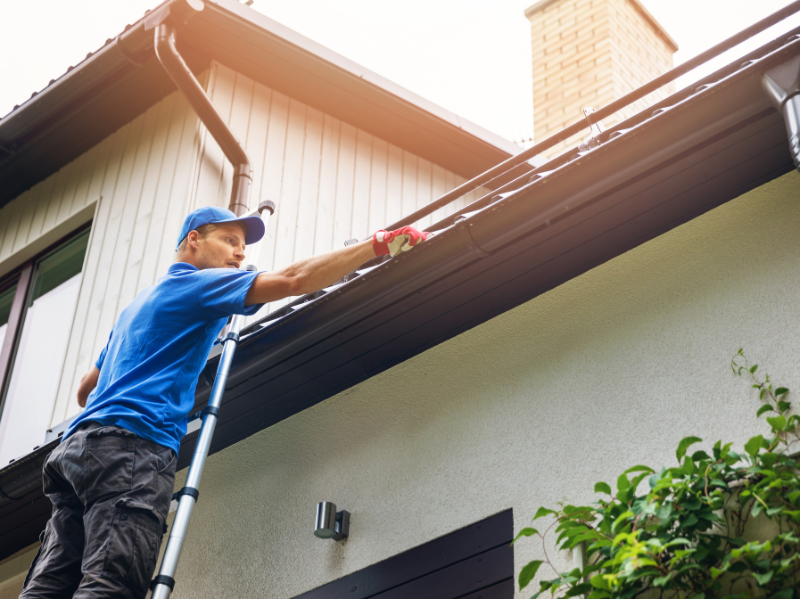Want to learn how to clean your gutters and downspouts so you can avoid roof leaks?
Overflowing gutters don’t just drench your siding—they flood your basement, crack your foundation, and turn your flowerbeds into splash zones. All from a few leaves and muck? Yep. A single clogged gutter drain can back up rainwater faster than a busted plumbing line. But here’s the kicker—most of it’s preventable with a ladder, a garden hose, and about 45 minutes of your time.
If your gutter system is sagging under the weight of debris, this guide will save you a weekend headache—and a few thousand bucks in repairs.
Why Gutters and Downspouts Actually Matter
Some homeowners treat gutters like background noise—barely there, barely important. Until the roof leaks, the siding warps, or a wall starts smelling like a damp basement sock. That’s when reality hits: gutter cleaning isn’t optional—it’s home protection 101.
When gutters clog and downspouts back up, your drainage system fails, leading to costly water damage, stubborn mildew, and foundation cracks that don’t just go away. Here at Legacy Roofing, many of the roof leaks we see when conducting roof inspections are due to attic vents or gutter issues. Overflowing and underperforming gutters are often due to clogs!
Here’s why cleaning your gutters and downspouts is non-negotiable:
- Downspout cleaning keeps rainwater moving away from your house, not soaking into your crawlspace.
- Overflowing gutters lead to standing water near the roof, causing rot, leaks, and mold.
- Backed-up systems create the perfect storm for mildew, pests, and ice dams in winter.
- Installing gutter guards helps, but you still need to clean your gutters to remove heavy buildup.
- A clogged system can force water behind siding and windows, creating rot you won’t spot until it’s expensive.
- Skipping a quick hose flush through the clean downspout can turn a small problem into full-blown structural damage.
Signs Your Gutters Need Immediate Cleaning

If your gutters had a way to scream for help, it’d sound like drip, splash, thud—followed by a slow gurgle near your basement wall. Most people don’t check their gutters until the damage is obvious. But by then? Your plumbing bill and waterproofing costs are already climbing. Knowing what to watch for can save your home from costly repairs and keep your soil and siding intact.
Here’s what to look (and listen) for to care for your gutters:
- Water spilling over the edges like a busted water feature? Time to clean gutters.
- Plants or weeds sprouting from your gutter line = too much leaf and debris buildup.
- Stained siding or peeling paint near gutter seams signals overflowing moisture.
- You spot standing water near your foundation after rain—this could lead to cracks or a soggy basement.
- Downspouts not draining or gurgling during storms? You need downspout cleaning ASAP.
- Sagging or disconnected gutters mean they’re weighed down by too much gunk and wet leaf sludge.
- You need a leaf blower, a garden hose, or both just to find the bottom of the gutter? Yeah, it’s overdue.
What Tools You Actually Need (No Gimmicks)
You don’t need a robot, a monthly subscription box, or a six-in-one gadget from a late-night infomercial to keep your gutter system clean. Most of the best drainage tools are old-school, affordable, and sitting in your garage right now. The trick isn’t overbuying—it’s knowing what actually works against clogged gutters and downspouts.
Here’s what you need to clean your gutters:
- Sturdy gloves – You’ll need them for scooping debris, not shaking your fist when your hand meets a nail.
- Trowel or scoop – Especially helpful when you’re dealing with layers of packed-in soil and organic sludge.
- Garden hose with spray nozzle – Blast out remaining muck and test your drainage flow at the same time.
- Leaf blower – Works fast if the leaves are dry and you’re not a fan of scooping by hand.
- Plumber’s snake or drain auger – A lifesaver for breaking up clogs buried deep in the downspout.
- Bucket or tarp – Keeps mess off your roof and saves cleanup time after you’re done digging through debris.
- Gutter scoop – Designed for narrow channels where a hand trowel won’t fit.
Step-by-Step Gutter Cleaning That Doesn’t Waste Your Saturday
A clogged gutter is like a leaky secret your roof keeps until your basement starts smelling like wet socks. But here’s the good news: you don’t need to lose a full Saturday or your sanity to handle gutter cleaning. With the right plan (and a strong garden hose), you can knock this out before lunch and still make your tee time or couch nap.
Follow this foolproof, low-drama cleanup:
- Start near the downspout – It’s where most debris piles up and where blockages can do the most damage.
- Scoop out debris by hand or with a gutter tool – Dump the mess into a bucket or tarp below.
- Flush gutters with a garden hose – Start at the end opposite the downspout to push remaining debris toward it.
- Blast the downspout – If water backs up, try tapping it or feeding in the hose to break the clog.
- Inspect for water damage or sagging – Look for overflow signs, especially where your roof meets the gutter line.
- Do a final rinse and check drainage – Water should exit freely; if not, it’s time to call a downspout cleaning service.
- Schedule a reminder – Don’t wait for a rainstorm to remind you again. Put it in your phone calendar now.
Pro Tips for Flushing and Clearing Downspouts
A blocked downspout is like a traffic jam in your gutter system—water backs up, spills over, and starts quietly wrecking your roofline and foundation. Don’t give mold and rot the upper hand. Clearing those vertical drains is where the real protection kicks in. Here’s how to flush them fast—and flush them right.
Use these expert tricks to keep your downspouts flowing like they should:
- Blast with a garden hose first – Start from the bottom to check flow. If water doesn’t shoot out the top, there’s debris inside.
- Try a leaf blower in reverse – Remove the extension and blow from the bottom up to dislodge compacted leaves or gunk.
- Use a downspout cleaner or plumbing snake – For serious clogs, feed one in slowly and twist until resistance breaks.
- Flush again from the top – Once the clog breaks loose, send a hose down from the top to clear out remaining grit.
- Install leaf blower-compatible attachments – Some gutter tools let you connect a leaf blower for fast air-powered cleaning across your entire gutter line.
- Watch for signs of water damage near the foundation – Overflow from clogged downspouts can erode soil, seep into basements, and even crack foundations.
- Add extenders at the base – Downspouts should empty water at least 3–6 feet from the house to reduce long-term risks.
How Often Should You Clean Gutters—Really?
Cleaning your gutters and downspouts twice a year—typically in spring and fall—is the bare minimum. Homes surrounded by pine trees, windy landscapes, or dusty roads may need quarterly cleanings.
After major storms, it’s smart to check for twigs, shingle grit, or debris that can clog your gutter system fast. Even if you have gutter guards, inspect them at least once or twice a year to ensure nothing’s slipping through. And don’t forget your downspouts—every other gutter cleaning should include a proper downspout clean out to keep drainage flowing and prevent water damage.
When to Call the Pros Instead

If you worry about ladder safety or don’t have the time to clean your gutters, we get it. However, that doesn’t mean you should neglect your gutters, which in turn can affect your roof. Remember, roof leaks are often because of something else, like your gutters, not performing correctly.
- Your roofline is too steep or high – Risking your safety isn’t worth it for leaves and sludge.
- You have expensive gutter materials – Copper gutters require gentle cleaning and proper handling to avoid dings and corrosion.
- You’ve installed complex gutter systems – Homes with intricate gutter guards and multiple drainage channels can easily trap debris in hard-to-reach spots.
- You’ve had previous water damage – A pro can inspect for mold, rotting fascia, or foundation issues while cleaning.
- You’d rather not juggle a hose and scoop on a shaky ladder – No shame in outsourcing dirty work when precision and safety matter.
Quick FAQ on Gutter Cleaning
Even if you’ve mastered yardwork or know your way around a toolbox, gutter cleaning is still one of those tasks that raises eyebrows and questions.
Whether you’re wondering about timing, tools, or technique, here’s a quick rundown of the most common gutter cleaning FAQs—served up with clarity and zero fluff:
1. How often should you clean your gutters?
At least twice a year. Add extra sessions after heavy storms or during leaf-heavy seasons to prevent gutters and downspouts from clogging.
2. Are gutter guards a permanent fix?
Not exactly. Gutter guards help reduce buildup, but they don’t eliminate the need to clean your gutters. Expect to still check and clear them annually.
3. What happens if I skip gutter cleaning altogether?
Expect water damage in places you don’t want it—basements, foundations, fascia boards, and landscaping. Ignoring gutter cleaning could cost you big.
4. Can I DIY all gutter cleaning tasks?
Basic debris scooping is doable with gloves, a scoop, and a ladder. But for high gutters, steep roofs, or heavy clogs, pros can do it safer and faster.
5. Do I need to clean gutters even if it hasn’t rained?
Yes. Wind still carries debris, and dry blockages can lead to sudden overflows once rain hits. Keep your gutter cleaning regular regardless of weather.
The Verdict
One inch of rainfall can dump over 1,200 gallons on the roof of an average home. If your gutters and downspouts are clogged, that water isn’t draining—it’s scheming. It’s eyeing your basement, your siding, and maybe even your foundation.
Don’t wait for your gutters to become mini-swamps or host a family of squirrels. Call the pros at Legacy Roofing and get your gutter system flowing like it’s fresh off the showroom roof. Clean, clear, and critter-free.


